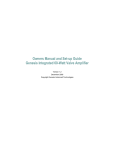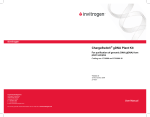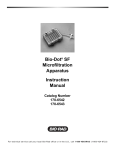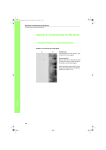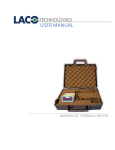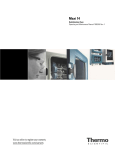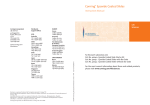Download Mega Northern mRNA Array
Transcript
Mega Northern mRNA Array Introduction Mega Northern mRNA Array is a novel tool for analysis of gene expression, combining the unique features of tissue mRNA arrays and mRNA Northern Blots. Using Mega Northern mRNA Arrays, not only gene expression but also gene size can be determined in many different tissues. The dimensions of this array are only 1x2 inches, and the detection method is the same as is commonly employed for Northern Blot analysis. 1. Corner that has been cut is upper __ __ __ __ __ Band 1 5 10 15 20 lane 1 lane 32 2. The two marked dots are 2 mm under lane 1 and 32 Actual Size: 1 x 2” Signal Locator Mega Northern mRNA Array. Left: A Human adult normal Mega Northern mRNA Array Composed of 32 Lanes (Cat# N8234480) was hybridized with non-radioactive labeled glyceraldehyde -3-phosphate dehydrogenase (GAPDH) DNA probe at 65 °C overnight, washed, detected by non-radioactive method, and exposed to X-film for 30 seconds. The array was hybridized in FastHyb hybridization solution (Cat# L1021250). Right: A transparent Signal Locator sheet is included for easy identification of the lanes and sizes of the signals. Features !" Reproducible results - The product comes in an array format. Any two arrays are nearly identical. !" Higher sensitivity - mRNA species are highly concentrated per unit area on the membrane and are readily accessible to probes. !" Versatile - Suitable for both radioactive and non-radioactive probes. !" Easy of use - The array can be treated/handled the same as a conventional Northern blot. !" Economical - One hybridization analysis reveals gene expression in many different tissues, and the smaller size of the membrane saves reagent costs. Applications !" Identification of tissue-specific genes in a wide variety of tissues !" Gene expression pattern analysis !" Comparison of expression levels of novel genes !" Determination of size and relative abundance of genes in different tissues !" Examination of alternative splicing and premature termination of specific gene transcripts Description BioChain’s Mega Northern mRNA Array was developed using a patent-pending proprietary technology. The Mega Northern mRNA Arrays are manufactured using high quality mRNA from documented tissue sources. A mRNA sample from each tissue is run 10 cm along with a RNA molecular weight marker on an agarose gel by electrophoresis and recovered from 20 fractions on the gel. Each mRNA fraction covers a defined molecular weight range. The recovered mRNA fractions are arrayed on positively charged nylon membranes and UV cross-linked. Each array can contain many more lanes than traditional RNA Northern Blots, and each lane is composed of 20 fractions. These arrays are suitable for use with both radioactive and nonradioactive probes. A user's manual and GAPDH control DNA probe are included. The Mega Northern mRNA Array is supplied ready to use, so that you can immediately screen genes of interest without the hassle of obtaining hard to find tissues and processing the RNA yourself. Overview Component Item Mega Northern mRNA Array GAPDH control probe Signal locator Amount 1 array 100 ng (10 µl) 1 Storage Room temperature, away from light and moisture -20ºC Room Temperature Storage Conditions: Store arrays at room temperature, away from light. Store control probe at -20°C. Materials Supplied by User The following reagents are required for use with these blots: !" Prehybridization/hybridization solution (see Recipes) !" Labeled probe !" Post-hybridization wash solutions The following equipment is required for use with these blots: !" Hybridization tube and hybridization oven or !" Heat-sealable plastic bags and a 30ºC-80ºC incubator Whenever possible, use hybridization tubes and a hybridization oven. This method reduces the possibility of radioactive contamination. Time Line The following table outlines the steps and times required for probing the Northern Blot. Step 1 2 3 4 5 Action Incubate the array in prehybridization solution. Hybridize the array with radioactive or non-radioactive labeled probe. Remove hybridization solution. Wash the array. Wash the array 2 more times. Expose the array to X-ray film A longer exposure is recommended for Mega Northern mRNA Array compared with the conventional Northern Blot Time 3h 16-24 h 30-45 min. 2 x 20 min. Minutes for nonradioactive probe, hours to days for radioactive probe Choosing a Probe Introduction A probe is a nucleotide sequence that is used to identify a specific RNA within a population of RNA. For this purpose there are several types of probe to be considered. Type of Probe Used when………….. Analyzing RNA population for the presence of a gene similar to the gene of interest. DNA RNA Oligonucleotide Analyzing RNA population for the presence of a particular gene using the genetic transcript Searching RNA population for the presence of a particular sequence that may be present in one or more gene transcripts Remember that the probe you choose will be binding the complementary sequence found in the RNA population. For more information, please refer to Current Protocols in Molecular Biology (Ausubel, et al., 1994) Probe Preparation You will need to have a labeled probe to hybridize to the array. For procedure on radioactive labeling probes, please refer to Probe Preparation or one of the following guides: Molecular cloning: A Laboratory Manual (Sambrook, et al., 2001) or Current Protocols in Molecular Biology (Ausubel, et al., 1994). For best results, the probe should be made from 25-50 ng DNA and have a specific activity of ! 108 cpm/ml. Unincorporated nucleotides should be removed by column chromatography or gel electrophoresis. 2 Positive Control Probe The cDNA fragment of the GAPDH gene is provided as a positive control for Mega Northern mRNA Array. Please note that GAPDH expression levels vary depending on the cell or tissue types and level of differentiation. These probes indicate lack of RNA degradation on the array. Please see Probe Preparation. Reprobing Mega Northern mRNA Array The Mega Northern mRNA Array may be stripped and reprobed several times. With successive uses, there might be an increased background level and a decreased hybridization signal. Please note that the quality of the signal obtained once the blot has been stripped and reprobed cannot be guaranteed. Caution Be aware that probes used with these arrays may be radioactively labeled. Wear gloves and a laboratory coat when working in a radioactivity designated area. Practice safe laboratory measures when using any radioactive isotope. Dispose of radioactive waste properly. Non-radioactive probes It is ideally to use non-radioactive probes with these arrays. There are several commercial products available for use in creating non-radioactive probes. Please follow the manufacture’s instructions for probe preparation and blot hybridization. Hybridization with Labeled Probes Important! It is very important that these arrays are NOT allowed to become completely dry at any time during the following procedure. It is possible to process multiple arrays at one time. It is not recommended that more than two be done together. Be sure that both arrays are fully exposed to the prehybridization/hybridization solutions. Diagram of Mega Northern mRNA Array Mega Northern mRNA Array is about 1 x 2 inches in size. Each spots within one lane represents a particular range of mRNA species. The upper left corner is cut to indicate correct orientation. Before Starting 1. Prepare approximately 12 ml of the prehybridization/hybridization solution (see Recipes). 2. If there is undissolved SDS present in the prehybridization solution, heat solution to 50ºC and mix gently to dissolve. 3. Prepare probe for hybridization. Please see Probe Preparation. Prehybridization 1. Place the array RNA side up in a hybridization tube (or a heat-sealable bag). 2. Add approximately 6 ml of the prehybridization solution (or enough to cover the array completely). 3. Incubate at 42ºC for 3 hours mixing gently for the entire incubation time (Rotate the hybridization tube or slowly shake the bag in an incubator or water bath). 3 Hybridization 1. If the labeled probe being used is double-stranded, denature it by heating at 100ºC for 5 minutes. Immediately transfer the probe to ice. 2. Add the probe to fresh prehybridization solution to a final specific activity of 10 cpm/ml to make the hybridization solution (see Recipes). 3. Remove the prehybridization solution from the array. 4. Add approximately 6 ml hybridization solution to the membrane. Remove all air bubbles. If you are using a resealable bag, it is a good idea to enclose this bag in a second bag in order to reduce the chances of contaminating the water bath. 5. Incubate at 42ºC for 16-24 hours with gentle mixing. (Rotate the hybridization tube or slowly shake the in an incubator or water bath) Note: BioChain’s FastHyb Solution (Cat# L1031250) is an ideally solution to do hybridization of BioChain’s RNA blot products including Mega Northern mRNA Array. Wash 1. Prepare 30 ml of Wash Solution 1 and 200 ml of Wash Solution (see Recipes). 2. Remove hybridization solution from the membrane and dispose of the radioactive solution properly. 3. Wash the array for 10-15 minutes with 10 ml of Wash Solution 1 with gentle mixing at room temperature. 4. Decant the wash solution and treat as radioactive waste. Repeat Step 3 two more times. 5. Wash the array for 20 minutes with 100 ml of Wash Solution 2 at 50ºC with constant gentle mixing. Decant the solution. 6. Repeat Step 5. 7. Remove the array from wash solution and immediately cover with plastic wrap. Proceed to Autoradiography. Autoradiography 1. Mark the plastic wrap with radioactive ink in order to be able to orient the array after exposure to Xray film. 2. Expose the array to X-ray film at -70ºC for 16-24 hours. A longer exposure time may be necessary. Results Interpretation A. Put the Signal Locator transparency sheet on top of the X-ray film to align the signals to the locations of the spots on the array. First make sure that the lanes are aligned to the signals. Since the second lane is negative control, there should be no signal obtained for that lane. Second, align the marked dots to the dots indicated on the Signal Locator to identify the fraction numbers that contain the signals. B. Size estimation of the transcripts: To estimate the size of the transcript after Northern Blot, first determine the numbers of which spots contain the most transcripts. There are twenty fractions from equal distances of gels for each tissue is arrayed. Each spot contain a range of different sizes of transcripts. When the number of the spot is determined, check the following table to estimate the size of the transcript. Spot Number 1 2 3 4 5 6 7 8 9 10 Sizes #26 kb 20 to 26 kb 15.5 to 20 kb 12 to 15.5 kb 9.2 to 12 kb 7.1 to 9.2 kb 5.5 to 7.1 kb 4.2 to 5.5 kb 3.2 to 4.2 kb 2.5 to 3.2 kb Spot Number 11 12 13 14 15 16 17 18 19 20 4 Sizes 1.9 to 2.5 kb 1.5 to 1.9 kb 1.1 to 1.5 kb 0.88 to 1.1 kb 0.68 to 0.88 kb 0.52 to 0.68 kb 0.40 to 0.52 kb 0.31 to 0.40 kb 0.24 to 0.31 kb 0.18 to 0.24 kb C. Multiple Spots for a transcript: In conventional Northern blot analysis, hybridization signals are not always shown as a thin narrow band. Instead, the band can occupy quite some length of the lane. For the production of Mega Northern mRNA Array, we used a special gel electrophoresis device to obtain highresolution mRNA fractions. Still it is common that signals for a transcript are found in two or more spots. It is because the transcript is at the edge of predefined two fractions. Determine the maximum signal intensity fraction by using the Signal Locator as described above. Probe Preparation Introduction The following protocol is for radioactive labeling a DNA probe using random primers. For additional protocols on probe preparation, please consult Molecular Cloning: A Laboratory Manual (Sambrook, et al., 2001) or Current Protocols in Molecular Biology (Ausubel, et al., 1994). Materials Supplied by User To prepare a labeled probe with a DNA restriction fragment you will need the following: 25-50 ng of DNA fragment in 23 µl distilled water random hexamer primers, 0.5 µg/ml 10X labeling reaction buffer 5 mM dATP 5 mM dGTP 5 mM dTTP [ -³²P] dCTP at 10 mCi/ml T7 DNA polymerase (2.5 units/µl) 0.2 M EDTA, pH 8.0 Sephadex G50 (Sigma) resuspended in TE buffer (1:1) 1.5 ml microcentrifuge tubes Labeling the Probe 1. Boil the DNA fragment for 5 minutes. Immediately place on ice. 2. Add the following: random hexamer primers 10 µl 10X labeling reaction buffer 5 µl dATP 2 µl dGTP 2 µl dTTP 2 µl [ -32P] dCTP 5 µl T7 DNA Polymerase 1 µl 3. The reaction stays at room temperature for 2 hours. 4. Add 5 µl EDTA to stop the reaction Removed Unincorporated Nucleotides 1. Poke a hole in the bottom of a 0.5 ml microcentrifuge tube using a pin or needle. 2. Add glass beads or wool to cover the bottom of the tube. 3. Fill the tube to the top with Sephadex G50 slurry in TE buffer 4. Place this tube within a second microcentrifuge tube and centrifuge at 1,500 x g for 4 minutes at room temperature. 5. Discard the elute. Fill the tube containing the Sephadex to the top with TE buffer and repeat centrifuge. 6. Repeat Step 5. 7. Place the tube containing the Sephadex into a clean microcentrifuge tube. 8. Add the labeling reaction to the column and centrifuge at 1500 x g for 4 minutes at room temperature. 9. The elute will contain the labeled probe. The unincorporated nucleotide should remain in the column. Discard the column as radioactive waste proceed to Estimating Specific Activity below. 5 NOTE There are several commercial labeling kits and spin columns available to be used in place of these protocols. If you plan to label the DNA probe using non-radioactive methods, please follow the manufacture’s instructions. Estimating Specific Activity To measure the incorporation of radioactivity in the probe you will need: STE buffer (see Recipes) Scintillation fluid and 5 ml scintillation vials Scintillation counter 1. 2. 3. 4. Transfer 2 µl of the labeled probe (Step 9, above) to 98 µl of STE buffer. Add 50 µl of the above diluted probe to 2 ml of scintillation fluid in a scintillation vial. Measure the radioactive counts in each sample. Multiply this number by 1000 µl/ml to determine the cpm/ml of probe. This number should be !108. Troubleshooting Please refer to the following table if you have difficulty with the Mega Northern mRNA Array. For additional assistance, please contact Technical Services using the details supplied or e-mail us at [email protected] Problem Poor hybridization signal Possible Cause Exposure time may be too short Probe specific activity may be too low Probe concentration in hybridization solution may be too low Probe is not freshly labeled High background Double-stranded probe is not denatured Use freshly labeled probes, <1 week old Denature double-strand probes Hybridization temperature is too low Increase hybridization temperature to 42ºC Hybridization time is too short Increase hybridization time to 24 hours Blot has been stripped and reprobed Decrease in hybridization signal is expected. Increase exposure time of array to X-ray film or try using a new array Remove unincorporated nucleotides from probe by chromatography or electrophoresis Ensure that the correct amount of DNA was used in the labeling reaction Ensure that there are no air bubbles present in hybridization tube or bag Increase volume of prehybridization, hybridization, and or wash solution Make sure that the prehybridization and hybridization solutions have been prepared properly deionized formamide immediately before use Optimal size range of probes is 200-800 bp nucleotides Use the shortest fragment possible that contains the sequence of interest Unincorporated nucleotides present Concentration of probe is too high Bubbles present during prehybridization/hybridization Membrane allowed to dry out during hybridization procedure Hybridization mixture is not correct Probe is too long Extra bands Solution Increase exposure time of blot to X-ray film up to 48 hours Check the probe to ensure that the initial 8 specific activity is !10 cpm/µg Ensure that the hybridization 6 Solution has the DNA probe at 10 cpm/µg Check amount of probe recovered after removal of unincorporated nucleotides Use a single-stranded probe Probe contains non-specific sequences 6 High background Unincorporated nucleotides present Remove unincorporated nucleotides from probe by chromatography or electrophoresis Recipes 10 X Labeling Reaction Buffer 0.4 M Tris-HCl (pH 7.5), 0.1 M MgCl2, 50 mM DTT, and 1 mg/ml BSA (Bovine Serum Albumin) 1. For 10 ml, dissolve 630 mg Tris-HCl, 95 mg MgCl2 , 7.7 mg DTT, and 10 mg BSA in 8 ml deionized water. 2. Bring final volume to 10 ml. 3. Store at -20ºC in 1 ml aliquots. 20 X SSC 3 M NaCl, 0.3 M C6H5Na3O7!2H2O (sodium citrate) 1. For 1 liter, dissolve 175 g NaCl and 88 g sodium citrate in 900 ml deionized water. 2. Adjust pH to 7.0 with 1 M HCl. Bring final volume to 1 liter with deionized water. 3. Store at room temperature. 50 X Denhardt’s Reagent 1% Ficoll (Type 400, pharmacia) 1% polyvinylpyrolidone (Sigma) 1% bovine serum albumin (Fraction V, Sigma) 1. For 500 ml, dissolve 5 g ficoll, 5g polyvinylpyrolidone, and 5 g BSA in 400 ml deionized water. 2. Bring to a final volume of 500 ml with deionized water. 3. Store at –20ºC. 20% SDS 1. For 100 ml, mix 20 g SDS with 80 ml sterile water, stir gently. It may be necessary to heat the solution to 50ºC in order to dissolve the SDS. 2. Add sterile water to a final volume of 100 ml with deionized water. 3. Store at 4ºC. Denatured, fragmented salmon sperm DNA 1. Dissolve 100 mg salmon sperm DNA in 10 ml deionized water. It may be necessary to stir the solution for several hours at room temperature. 2. Add NaCl and adjust the concentration to 0.1 M. 3. Perform a phenol extraction, followed by a phenol: chloroform extraction. Transfer the upper aqueous phase to a new tube. 4. Shear DNA with a 17-gauge needle. 5. Precipitate DNA with 2 volumes of ice-cold ethanol. 6. Wash pellet with 80% ethanol and air dry. 7. Redissolve DNA in water at 10 mg/ml 8. Measure OD260 and calculate concentration. 1OD260=0.05 µg/µl DNA. 9. Boil the solution for 10 minutes. 10. Store at –20ºC in 1 ml aliquots. 11. Before using , heat solution in boiling water for 5 minutes. Prehybridization Solution (Per 100 ml) 20 X SSC 50 X Denhardt’s reagent 10 mg/ml denatured, fragmented salmon sperm DNA Freshly deionized formamide 20% SDS Sterilized water 30 10 1 50 2.5 6.5 ml ml ml ml ml ml 1. Mix together the reagents listed above, 20 X SSC, 50 X Denhardt’s reagent and Salmon sperm DNA are made up as stock solution. 7 2. It may be necessary to heat the solution to 50ºC in order to dissolve the SDS. 3. You will use 6 ml of this solution for prehybridization and 6 ml to make the hybridization solution. 4. The solution may be stored at 4ºC for 2 weeks. For long-storage, place the solution at –20ºC. Hybridization Solution (per 6ml) 6 ml prehybridization solution (see above) Radioactive labeled probe (specific activity > 108 cpm/ml) 1. The final specific activity of the hybridization solution should be 106 cpm/µl. To determine the amount of probe needed, use the following equation: Y ml (1 x 106 cpm/ml) X µl = Z cpm/µl X = the amount of probe to add Y = the volume of hybridization solution Z = the specific activity of the probe 2. Thoroughly mix the probe with the prehybridization solution. Where Note: Using BioChain’s FastHyb solution (Cat# L1031250) can save all the above material and time in making hybridization solution. Following the simple protocol of FastHyb will give you the best hybridization results from BioChain’s RNA blot products. Wash Solution 1 2X SSC 0.05% SDS 1. For 500 ml, add 50 ml 20X SSC and 1.25 ml 20% SDS to 449 ml sterilized water. Mix. 2. Store at room temperature. Wash Solution 2 0.1X SSC 0.1% SDS 1. For 500 ml, add 2.5 ml 20 X SSC and 2.5 ml 20% SDS to 495 ml sterilized water. Mix. 2. Store at room temperature. STE Buffer For a 50 ml volume: 1. Add 0.438 g NaCl to 40 ml of TE buffer. 2. Adjust pH to 8.0 with HCl. 3. Bring volume up to 50 ml with TE buffer. 4. Store at 4ºC. References 1. Ausubel, F. M. , Brent, R., Kingston, R. E, Moore, D. D., Seidman, J. G., Smith, J. A. and Struhl, K., eds (1994). Current protocols in Molecular Biology.Greene Publishing associates and WileyInterscience. New York 2. Hames, B. D. and Higgins, S. J., eds (1993) Gene Transcription: A Practical Approach. Oxford University Press. Oxford 3. Sambrook, J., Fritsch, E. F. and Maniatis, T. (2001). Molecular Cloning: A Laboratory Manual, 3rd Edition. Cold Spring Harbor Laboratory Press.Plainview,New York.








